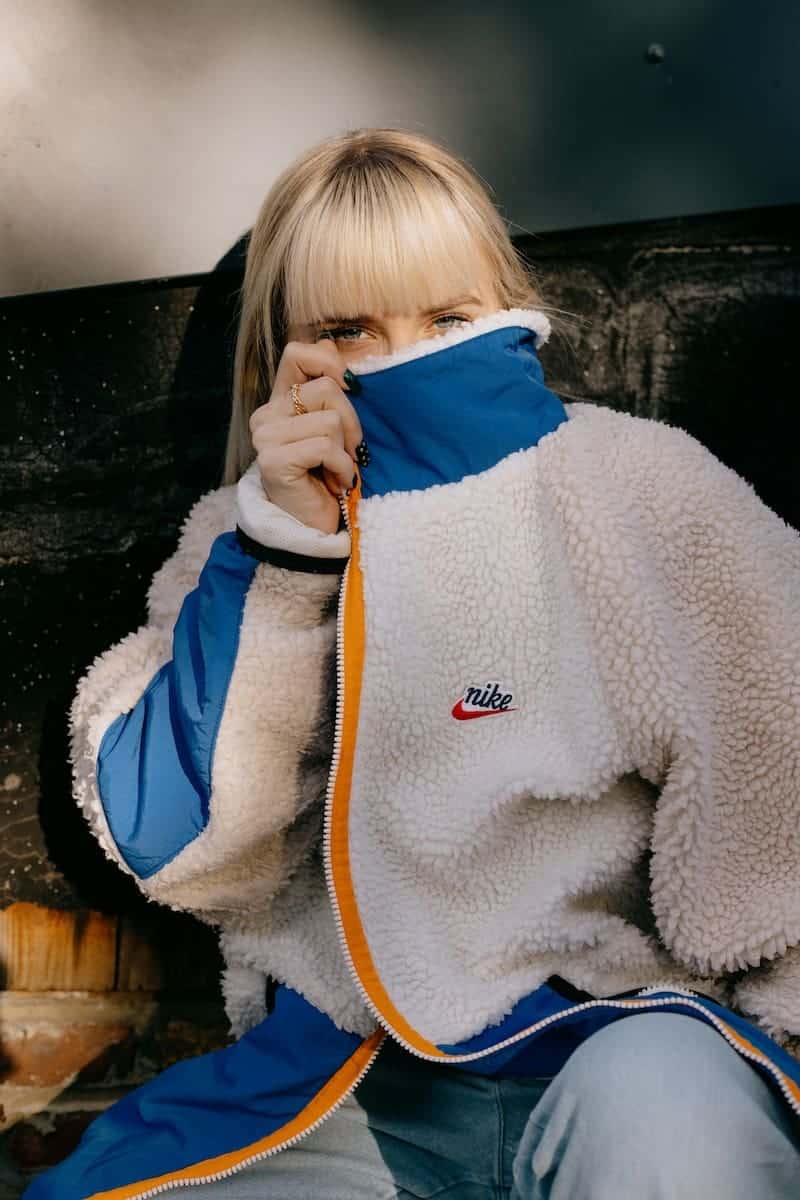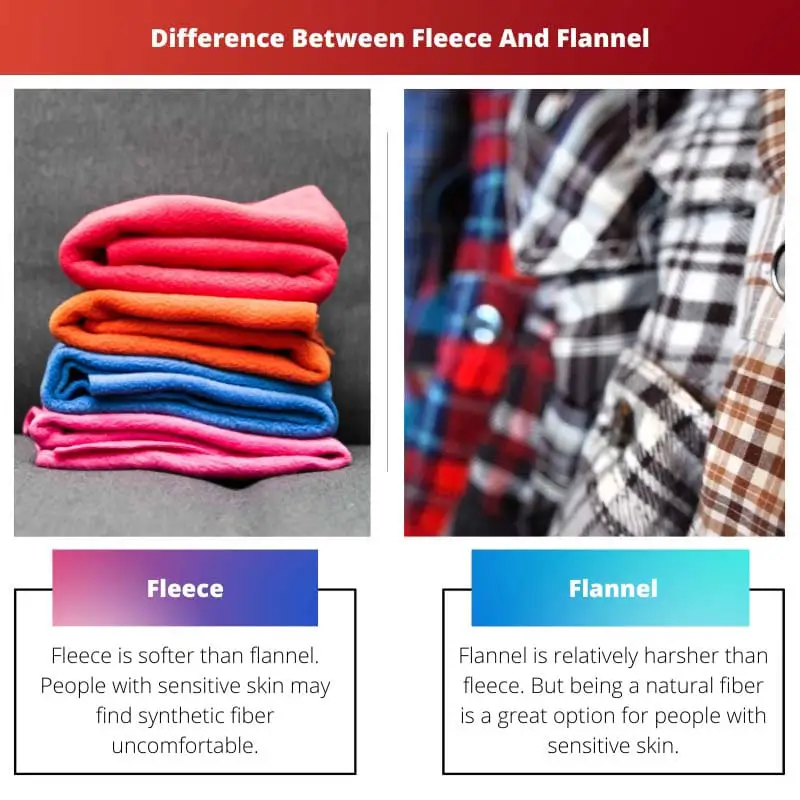The rains and winters bring cold air, hot chocolate, festivities, and a new opportunity to style trendy and unique clothing items. Fleece and Flannel are evergreen and classy clothing articles for anybody looking to amp up their wardrobe and experiment with various styles and designs for their favorite clothes.
Key Takeaways
- Fleece is a synthetic fabric made from polyester fibers, while flannel is a soft, woven fabric made from cotton or wool.
- Fleece is known for its exceptional warmth and moisture-wicking properties, whereas flannel provides moderate warmth and a cosy feel.
- Flannel is commonly used for bedding and clothing, while the fleece is popular for outerwear, blankets, and activewear.
Fleece vs Flannel
Fleece is a warm, knit fabric made thick by wrapping threads around each other from man-made materials like polyester. Flannel is a loosely woven lightweight and soft, brushed or unbrushed fabric, made from wool, cotton or synthetic fiber that is worn in winters to keep a person warm.

Fleece is a soft, warm fabric used as a mid-layer for outdoor clothing. It is created with polyester or a blend with other natural fibers.
Fleece is derived from melted plastic, which is turned into tiny fibers through modern science technology in textiles and twisted into yarn.
Flannel is another soft, fluffy fabric used in winter clothing. It is created from natural fibers such as cotton or a blend of other natural fibers.
It is a medium-weight fabric that can be fuzzy with a finish on one or two sides. It is brilliant in temperature regulation.
Comparison Table
| Parameters of Comparison | Fleece | Flannel |
|---|---|---|
| Softness | Fleece is softer than flannel. People with sensitive skin may find synthetic fiber uncomfortable. | Flannel is relatively harsher than fleece. But being a natural fiber is a great option for people with sensitive skin. |
| Nature-friendliness | Fleece is more eco-friendly when the products are made from recycled plastics. | Flannel is less eco-friendly because of the immense amount of water used in the production of cotton. |
| Is it Budget-friendly? | Man-made fibers are cheaper due to the reduced cost of production. | Flannel is relatively expensive due to the increased cost of production because of organic sources. |
| Durability | It is more durable than flannel. | Flannel fibers are not as durable as fleece. |
| Breathability | Fleece is less breathable due to the unpermeable solid fibers. | Flannel is more breathable due to the loosely woven strands for effective airflow between the strands. |
What is Fleece?
Fleece is an incredible product. It is an entirely man-made product, developed from polyester. The fabric is created with the help of recyclable plastic products.
Some fleece products are developed with a blend of natural and synthetic fibers.
The introduction of fleece dates back to the 1970s when it was introduced in the textile industry as sportswear products. The microfibers in fleece resemble the structure of fine fur.
It corresponds to the structure of sheep fur. Fleece is an ideal outdoor winter and sportswear gear.
It is a great fabric to provide coziness and warmth to the people. The fabric that was developed as sportswear, in the beginning, has grown into a versatile garment perfect for winters.
You can find fleece garments and accessories in a variety of shades, designs, and patterns.
It is commonly used in sweaters, jackets, shirts, sweatshirts, pullovers, and a wide range of other winter clothing items. Fleece is a stylish, warm, and unique fabric that offers a wide range of advantages.
The fleece material is made up of tight-knit polyester fibers, which provide it with a fine structure, making it ideal for colder temperatures.
The fabric can handle very low temperatures and is effective in temperatures below zero degrees.

What is Flannel?
Flannel is a soft, fuzzy cotton spun fabric woven into a wide range of products. The loosely spun weave is ideal for winters.
The history of flannel starts back in the 17th century. The origin of flannel is Wales. Flannels were created with the help of wool to get their fluffy structure.
In the 20th century, the flannel was mostly designed with the help of cotton. Some flannel products are made with a blend of cotton with silk and wool.
It is a perfect fabric for colder climates as it is warm to protect you against the harsh climate. The softest flannel is created with 100% cotton. Flannel is popularly available in a plaid design.
With an improvement in technology, you can find flannels in various designs and patterns. The striking feature of flannel is that the fabric gets softer with time.
It is highly low-maintenance and easy to care for.
It does not require frequent cleaning and washing. The lightweight, flush texture of the fabric makes it highly appropriate for winters.
It is a popular choice for clothing like jackets and shirts, boots, bedsheets, and lining of coats. Flannel does not hold odor and can last without many washes.

Main Differences Between Fleece and Flannel
- Fleece is more capable of holding heat and providing warmth than Flannel. The moisture-wicking technology provides intense insulation to the fabric better than Flannel.
- Fleece has more strength than Flannel and can easily sustain fewer wash cycles than flannel.
- Fleece is not efficient at heat regulation. Whereas, Flannel is an effective fabric in preventing the overheating of the body.
- Fleece does not shrink during washing and cleaning, whereas Flannel is more likely to shrink during washing which affects its quality in the long run.
- Fleece lasts longer than Flannel. Fleece has strong knitted fibers that do not wear out easily. Flannel has a shorter life and may last 3-4 years if the product is high-quality.

- http://ozbud.net/asrfqkuwdr/yyp-blankets-super-cnmanufactures-32779089.html
- https://jamanetwork.com/journals/jamapediatrics/article-abstract/1175260
